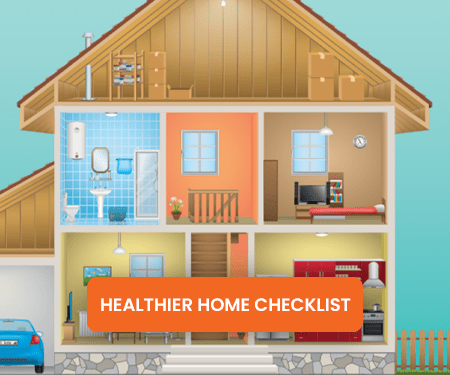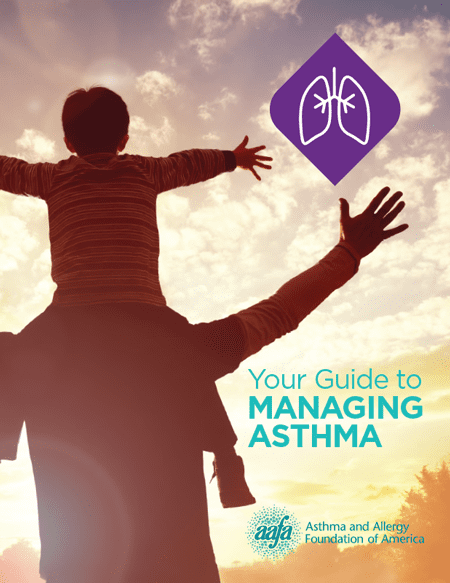Asthma
Air Pollution and Asthma
Air pollution can cause asthma and other lung diseases. It also worsens asthma symptoms, leads to increased hospital visits, and can cause early death.
What Is Air Pollution?
Air pollution is contamination of the air with substances that harm human health or the environment. The pollution may be gases, chemicals, or small particles in the air.
Air pollution can increase your risk of getting asthma or can worsen your symptoms if you already have asthma.
Airborne Particles
Small airborne particles, found in haze, smoke, soot, and airborne dust can lead to serious air quality problems.
Small airborne particles are called “particulate matter” or PM. The smallest particles (PM2.5) are the most dangerous. They can get deep into the lungs or even your blood.
- PM10 examples: dust, pollen, mold
- PM2.5 examples: combustion particles, compounds, metals, smoke and soot, emissions
People with asthma are at greater risk from breathing in small particles and irritating gases. They can irritate the airways and make asthma worse.1
Ozone (O3)
Ozone, a gas, is one of the most common air pollutants. Ozone is helpful in the upper atmosphere but causes problems when it is found closer to the ground in the air we breathe. Ground-level ozone is part of “smog” or haze. It is most common in cities where there are more cars and use of fossil fuels. It is also more common in the summer when there is more sunlight, heat, and low winds. Ground-level ozone is created by chemical reactions between emissions of burning fuel emissions and volatile organic compounds (VOC), heat, and sunlight. It is associated with worsening respiratory diseases such as asthma and chronic obstructive pulmonary disease (COPD). Ozone triggers asthma because it is very irritating to the lungs and airways.
Nitrogen dioxide (NO2), Sulfur dioxide (SO2), Carbon monoxide (CO), Methane (CH4)
Other gases can also affect your health and environment.
Nitrogen dioxide (NO2) comes from burning fuels. It also forms from emissions from cars, trucks, other vehicles, and power plants. It is part of smog (haze). Breathing in NO2 can cause someone to develop asthma. It can worsen lung disease, especially asthma.3
Sulfur dioxide (SO2) comes from burning fossil fuels, transportation, volcanoes, and industrial processes. It can be found in smog or haze. SO2 can harm plants (including trees). It can harm your lungs and lead to health problems.4
Carbon monoxide (CO) forms from incomplete combustion of fuels and wood. It has no smell. It can be very dangerous when it builds up inside buildings, homes, and cars.
Methane (CH4) is another gas that is part of air pollution. It mostly comes from animal agriculture and in subarctic regions where it is released from melting permafrost. Fossil fuels (oil, gas, coal) and waste (food, landfills, wastewater) also add methane to the air. Methane is 30 times more potent at trapping heat than carbon dioxide (CO2) as a major greenhouse gas that is worsening the climate crisis. Methane can turn into ground-level ozone, which is harmful to human health.5
The United States Environmental Protection Agency (EPA) defines air pollution as “any visible or invisible particle or gas found in the air that is not part of the natural composition of air.”
How Does Air Pollution Affect Asthma and Health?
Small particles and gases in the air can pass through your nose or mouth and get into your lungs and blood. Both long-term and short-term exposure to air pollution can cause many health problems.
Breathing in air pollution can cause:
- Breathing problems
- Asthma attacks
- Difficulty breathing deeply
- Worsened asthma symptoms
- Decreased lung growth in kids
- Reduced lung function
- Needing more doses of asthma drugs
- Needing emergency treatment for asthma
- Heart and blood vessel diseases
- Hospital visits
- Adverse birth outcomes (such as preterm birth, low birth weight, stillbirth)
- Early death6
Who Is Most at Risk from Air Pollution?
At high levels, air pollution can be harmful to everyone. But even lower levels of air pollution can harm health.
The groups most at risk from harmful effects of air pollution include:
- People with lung disease like asthma
- People with heart disease
- Babies and children
- Senior adults
- People who work outside
- People who are active or exercise outdoors
- Individuals who are pregnant and their fetuses
- People who live near sources of pollution (busy roadways, power plants, industrial facilities, oil and gas production sites)
- People who have lower incomes
- Black communities, Hispanic communities, and Native American/Indigenous communities
How Do I Know If My Area Has Air Pollution?
The EPA reports air pollution levels using the Air Quality Index (AQI). AQI reports on ozone, particle pollution, sulfur dioxide, nitrogen dioxide, and carbon monoxide.
When the AQI is 101 or higher, it is unhealthy for people with asthma. You may have to change your activities and medicines. If you have asthma, your symptoms can worsen even when AQI levels are moderate (AQI 51-100).
Many local weather forecasts warn the public about high air pollution days. You can find this information anytime at AirNow.gov.
When air pollution is high, people with asthma should limit their time outdoors, especially from 11 a.m. to 8 p.m. Stay in a well-ventilated, preferably air-conditioned, building. Most of all, do not exercise or work hard outdoors when the AQI is at unhealthy levels.
Should I Be Concerned About Air Pollution in My Home?
Yes. Your home might even be a “high priority public health risk.” This is probably where you are exposed to most allergens and irritants.
Home is where you cook, eat, sleep, bathe, groom, relax, and play with pets. Indoor air pollution can pose a health risk. Your home may have small particles in the air or damaging gases such as carbon monoxide.
Sources of indoor air pollution include:
- Household cleaners and air-freshening sprays or devices
- Fuel-burning heat sources (such as a wood-burning stove)
- Smoke from cooking, candles, fireplaces, or tobacco
- Toxic fumes that are “off-gassing” from new products (new furniture and new carpet)
- Attached garages that store cars, motorcycles, or lawnmowers (can add carbon monoxide to your air)
- Building and paint products (paints, adhesives, solvents)
- Pesticides (such as treatments for cockroaches and fleas)
- Radon (a gas that comes from the ground and enters a home and can rise to dangerous levels)
- Humidity that allows mold to grow
- Cosmetics, perfumes, and hair sprays
To reduce your home’s indoor air pollution:
- Remove or reduce allergens
- Do not smoke tobacco products in your home
- Prevent mold growth by lowering the humidity in your home by using exhaust fans in kitchens, bathrooms, and laundry rooms (or open a window if necessary)
- If you live in a humid area, consider getting a dehumidifier for your home
- Increase air flow to give your house better ventilation (open windows, doors)
- Store harmful products in a shed that is not attached to your home
- Avoid using scented candles or odor-hiding fragrances
- Install and check carbon monoxide alarms and radon alarms
- Install Certified Asthma & Allergy Friendly® air cleaners or filters
Should I Worry About Air Pollution in My Work Environment?
Yes, but your concern should be appropriate to the type of environment you work in. If you work outdoors, or if you work with certain chemicals, sprayed substances, powders or known carcinogens or allergens, your risk may be high. The Occupational Health and Safety Administration (OSHA) requires your employer to reduce your risk.
Even if you work in what seems to be a chemical-free environment, you may have exposure to indoor or outdoor air pollution. No matter how old the building is, there may be hidden indoor air pollution. Buildings may have mold spores or cockroaches. These are both powerful allergens. Dust mites are in most indoor areas. New carpet may release toxic fumes. Poorly filtered air systems may spread allergens and irritants. If they are damp, they may actually breed mold spores. If your employer allows tobacco smoking in the building, smoke may pollute the air you breathe.
Medical Review: April 2024 by Miriam Anand, MD, and Jeffrey G. Demain, MD
Closed
References
- https://www.cdc.gov/climateandhealth/effects/air_pollution.htm
- https://www.epa.gov/ground-level-ozone-pollution/ground-level-ozone-basics#effects
- https://www.epa.gov/no2-pollution/basic-information-about-no2#Effects
- https://www.epa.gov/so2-pollution/sulfur-dioxide-basics#effects
- https://www.epa.gov/ghgemissions/overview-greenhouse-gases#methane
- https://www.who.int/teams/environment-climate-change-and-health/air-quality-energy-and-health/health-impacts
Asthma Capitals
Where you live can have an impact on your asthma. AAFA’s Asthma Capitals™ report looks at the top 100 most challenging cities in the continental United States to live with asthma.
























